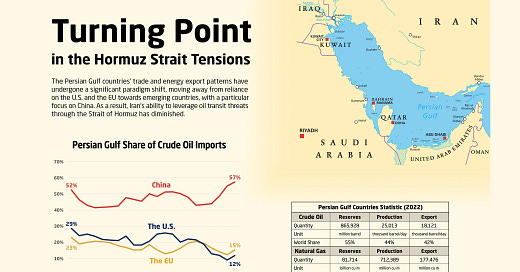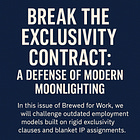The Sunday Brew #131
In this brew - Persian Gulf Crude Exports in a picture | Hempel’s Paradox & The Sorites Paradox | Israel - Iran war, AI 171 Boeing 787 Crash in India, and Amazon, Walmart to launch stablecoin
Welcome to The Sunday Brew, weekly 1-2-3 newsletter by The Percolator. Every Sunday we drop in your inbox 1 story in a picture, 2 concepts, ideas or frameworks to expand your horizons and 3 news from the week, to keep you updated.
If you are not a paid subscriber, here is what you missed last week:
ONE STORY IN A PICTURE
TWO IDEAS, FRAMEWORKS OR CONCEPTS
This week we bring to you two paradoxes - Hempel’s Paradox & The Sorites Paradox
Hempel’s Paradox
Hempel’s Paradox, also known as the Raven Paradox, is a thought experiment in the philosophy of science that challenges our intuitions about what constitutes evidence for a general statement.
The paradox begins with the hypothesis “All ravens are black.” Logically, this is equivalent to saying, “If something is not black, then it is not a raven.” In scientific reasoning, observing a black raven supports the hypothesis that all ravens are black, which aligns with our intuition.
However, the paradox arises when we consider the logically equivalent statement. If we see a green apple, which is neither black nor a raven, it fits the statement “If something is not black, then it is not a raven.” According to the rules of logic, this observation should also count as evidence for the hypothesis that all ravens are black. This leads to the unintuitive conclusion that looking at non-black, non-raven objects—like green apples, white handkerchiefs, or red cars—provides evidence that all ravens are black.
The paradox exposes a tension between two principles: first, that logically equivalent statements should be interchangeable in reasoning, and second, that only observations directly related to the subject (in this case, ravens) should count as evidence. Some philosophers, including Hempel himself, accept the logical result but argue that the reason it feels paradoxical is that we tacitly use background knowledge—knowing that most objects are not ravens, so seeing another non-raven adds very little to our confidence in the hypothesis.
In practice, observing a black raven is much more informative than observing a green apple, even though both technically confirm the hypothesis. The Raven Paradox thus highlights the complexities of confirmation and evidence in scientific reasoning, showing that our intuitions about evidence do not always align with formal logic.
🚀
The Sorites Paradox
The Sorites Paradox, also known as the paradox of the heap, arises from the vagueness inherent in certain terms and concepts, particularly those without clear boundaries.
The classic formulation involves a heap of sand: if you remove a single grain from a large heap, it remains a heap. If you repeat this process, each time removing just one grain, logic seems to dictate that it is still a heap after each removal. However, if you continue this process enough times, you are eventually left with just one grain, which no one would consider a heap. This leads to the puzzling conclusion that a single grain of sand could be considered a heap if you strictly follow the reasoning step by step.
The paradox exposes a fundamental problem with vague predicates—terms like “heap,” “bald,” or “tall”—because there is no precise point at which the application of the term suddenly stops being appropriate. The incremental changes between each step (removing or adding a single grain) are too small to make a clear difference, yet the cumulative effect is dramatic.
Philosophers have debated the implications of the Sorites Paradox for centuries, as it challenges the idea that every concept must have strict boundaries and raises questions about how language and logic handle vagueness. Some responses to the paradox suggest that our language is inherently imprecise and that trying to impose sharp boundaries on vague concepts is misguided. Others have attempted to formalize ways to deal with vagueness, but the paradox remains a central puzzle in philosophy, logic, and the study of language.
THREE NEWS FROM THE WEEK
Israel-Iran War: Direct Conflict Shakes Middle East, Raises Global Concerns
On June 13, Israel launched “Operation Rising Lion,” a series of coordinated airstrikes targeting Iranian nuclear facilities, missile sites, and senior military leaders across more than a dozen locations, including Tehran, Natanz, and Khondab. Several top Iranian commanders and nuclear scientists were killed, and key infrastructure was damaged.
Israel stated its actions were a preemptive measure to cripple Iran’s nuclear ambitions and protect its national security, while Iran condemned the strikes as a violation of its sovereignty and vowed severe retaliation. Within hours, Iran responded with “Operation True Promise III,” firing over 150 ballistic missiles and more than 100 drones at Israeli cities and military sites. The attacks caused casualties and significant damage, and triggered air raid alerts across Israel.
Both nations closed their airspace, and the conflict disrupted regional oil production and global shipping routes, causing economic ripples worldwide. Amid the escalating violence, diplomatic efforts suffered a major blow. The United States, while informed in advance, did not participate directly and called for restraint from both sides.
The latest round of U.S.-Iran nuclear talks, scheduled to take place in Oman, was suspended indefinitely after the Israeli strikes. Iranian officials described further negotiations as “pointless” in the current climate, blaming U.S. support for Israel’s actions. The collapse of talks has heightened fears of nuclear proliferation and prolonged instability in the region.
The war’s unprecedented direct strikes and retaliation have left the region on edge, underscoring the volatility of the Israel-Iran rivalry and the global stakes involved.
➖
Air India Boeing 787 Dreamliner Crash in Ahmedabad: 241 Dead, Safety Questions Raised
An Air India Boeing 787 Dreamliner, operating as flight AI171 from Ahmedabad to London Gatwick, crashed less than a minute after takeoff on June 12, 2025, killing 241 people in one of India’s deadliest aviation tragedies. The aircraft, carrying 230 passengers and 12 crew, plummeted from 625 feet and exploded in a residential area near Ahmedabad airport, igniting a massive fire and causing additional casualties on the ground.
Authorities have confirmed that only one person, a British national of Indian origin seated in 11A, survived and is being treated for injuries. The victims included 169 Indian nationals, 53 British, seven Portuguese, and one Canadian.
Eyewitnesses reported seeing the Dreamliner flying unusually low and struggling to gain altitude before it slammed into a building housing a medical college hostel, killing several students and residents. Emergency teams recovered at least 270 bodies, many severely burned, and are using DNA matching for identification.
Shortly after takeoff, the pilots issued a “mayday” call, but contact was lost moments later. Experts say the aircraft failed to achieve lift, possibly due to technical issues with the flaps, engines, or landing gear, though the exact cause remains under investigation. The black box was recovered within 28 hours and is expected to provide crucial data for investigators.
The crash has also brought renewed attention to Boeing’s manufacturing and safety practices. Over recent years, whistleblowers and some former employees have raised concerns about potential shortcuts and pressure within Boeing’s production lines. While Boeing maintains that the 787 undergoes rigorous safety checks and meets all regulatory standards, these allegations have prompted regulators in India and the U.S. to scrutinize Boeing’s safety culture more closely.
Indian authorities have ordered inspections of all Boeing 787 aircraft operating in the country as part of the ongoing investigation. Prime Minister Narendra Modi and the Civil Aviation Ministry have expressed condolences and pledged full support to the victims’ families.
➖
Walmart and Amazon Eye Launch of Dollar-Pegged Stablecoins Amid Regulatory Shift
Walmart and Amazon are reportedly exploring the launch of their own U.S. dollar-pegged stablecoins, signaling a potential transformation in how payments are processed across the retail sector. While neither company has officially confirmed the plans, sources say both giants are in early discussions to develop brand-specific digital tokens that could be used for customer payments.
The move comes as both retailers seek to reduce the billions of dollars they pay annually in credit card and banking fees. By adopting stablecoins, which are designed to maintain a stable value by being pegged to the U.S. dollar, Walmart and Amazon could streamline transactions, speed up settlements, and enhance customer loyalty programs. Currently, merchants pay 1–3% per transaction in fees to networks like Visa and Mastercard—a significant cost for companies processing hundreds of billions in sales.
The timing aligns with growing regulatory clarity in the U.S. Congress, where the GENIUS Act—a bill that would establish a framework for private companies to issue stablecoins—is moving forward. The outcome of this legislation could be pivotal for the proposed launches, as it would set the legal groundwork for non-financial companies to issue digital currencies.
If realized, Walmart and Amazon’s stablecoins could disrupt traditional payment networks and accelerate the mainstream adoption of digital assets in retail. Industry observers note that other major companies, including Expedia and Shopify, are also exploring stablecoin payments, reflecting a broader trend in the sector.
While still in the exploratory phase, the potential launch of Walmart and Amazon stablecoins marks a significant step toward integrating crypto technology into everyday commerce.
The Sunday Brew by The Percolator brings to you curated news on tech, business & entrepreneurship, from across the internet to give your week a perfect start.
Share your thoughts and opinions on the topics covered in this newsletter by leaving a comment and joining the conversation.








